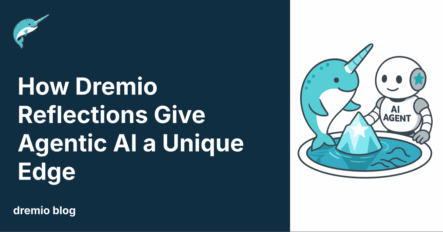12 minute read · September 12, 2025
How Dremio Reflections Give Agentic AI a Unique Edge
· Head of DevRel, Dremio

Traditional business intelligence relied on static dashboards and predictable queries, where materialized views and cubes could be tuned once and used repeatedly. But the rise of agentic AI has upended that model. Instead of fixed reports, AI agents generate ad-hoc, ever-changing questions that demand instant, accurate answers from massive datasets. Meeting these requirements with yesterday’s acceleration techniques quickly leads to brittle pipelines, stale data, and endless manual tuning. Dremio’s reflections were built for this new reality. By automatically adapting to query patterns, keeping results fresh with live and incremental refreshes, and enabling autonomous performance optimization, reflections deliver the consistent, low-latency access that AI systems need to operate effectively. This blog will explore how reflections work, how they improve on traditional methods, and why they give agentic-AI projects a unique performance edge.
Traditional Acceleration: Materialized Views and Cubes
For decades, data teams have leaned on materialized views and cubes to accelerate analytical workloads. A materialized view is essentially a pre-computed query result stored like a physical table. By caching query results in advance, materialized views reduce the need to scan large volumes of raw data repeatedly. This approach works well for predictable queries, think monthly revenue by region or customer churn by quarter, where the underlying SQL changes little over time.
Cubes emerged as another powerful method of precomputation, particularly for multidimensional analysis. By pre-aggregating data across dimensions (such as time, product, geography), cubes allow business intelligence tools to deliver lightning-fast “slice-and-dice” exploration. Analysts can drill into categories or roll up to summaries without waiting for expensive aggregations to run in real time.
These approaches represented the best of performance engineering in their era. They were designed for stable query patterns, dashboards refreshed on schedules, and workloads where users asked the same questions over and over. However, as query patterns become less predictable, especially in AI-driven scenarios, the limitations of these traditional methods begin to show.
The Challenges with Traditional Approaches
While materialized views and cubes once offered reliable performance boosts, they come with trade-offs that make them less suited for today’s dynamic workloads.
- Managing refreshes – Both materialized views and cubes require explicit refresh schedules. If the refresh window is too infrequent, users are left querying stale data. If it’s too aggressive, refresh jobs consume excessive compute resources and can collide with production workloads. Striking the right balance becomes an ongoing operational challenge.
- Updating queries – These acceleration structures are tied to specific queries or aggregations. If business requirements change, or if a new query pattern emerges, the data team must rebuild or reconfigure the materialization. This adds friction and slows the ability to adapt to evolving needs.
- Limited reusability – A materialized view or cube is often optimized for one use case. If another query needs slightly different dimensions, filters, or joins, it won’t benefit from the existing structure. This leads to proliferation: dozens or even hundreds of overlapping materializations that become difficult to maintain.
- Scalability concerns – As data volumes and dimensionality grow, cubes can balloon in size and complexity. Storing every possible pre-aggregation across multiple dimensions quickly becomes impractical, and refresh times can stretch into hours or days.
For agentic AI use cases, where queries are generated on the fly and shift constantly, these drawbacks compound. The overhead of manually designing, managing, and refreshing acceleration structures becomes a bottleneck, preventing AI systems from accessing fresh data at the speed they require.
Try Dremio’s Interactive Demo
Explore this interactive demo and see how Dremio's Intelligent Lakehouse enables Agentic AI
What Makes Dremio’s Reflections Different
Dremio tackles these challenges with reflections, its next-generation approach to query acceleration. Unlike materialized views or cubes, reflections are not tied to a single query or fixed set of aggregations. Instead, they act as intelligent, reusable optimizations that Dremio’s query planner can substitute automatically whenever they match part, or all, of a user’s query.
This design eliminates the need for analysts to rewrite SQL or point dashboards to special tables. Users continue querying the logical datasets they know, while behind the scenes Dremio transparently determines whether a reflection can accelerate the request. Because reflections are managed within Dremio itself and stored as Apache Iceberg tables, there’s no need for extra ETL pipelines or external orchestration.
What’s especially powerful is that reflections are built for adaptability. They can refresh incrementally to stay aligned with changing data, and they aren’t locked to a single workload. One reflection can serve dozens of different queries across BI dashboards, ad-hoc SQL, and even AI-driven workloads. This combination of automation, reusability, and flexibility is what sets reflections apart from traditional acceleration techniques, and makes them uniquely suited to meet the unpredictable demands of agentic AI.
How Reflections Work and Their Different Types
At their core, reflections are optimized physical representations of your data that Dremio’s query planner can substitute automatically to accelerate queries. They live alongside your logical datasets but are stored as Apache Iceberg tables, which means they benefit from modern table format features like partition pruning, schema evolution, and time travel.
Dremio supports several types of reflections, each designed to accelerate different query patterns:
- Raw Reflections – These store the full dataset (or a subset of columns) in an optimized layout. By pre-partitioning, sorting, or distributing the data, raw reflections dramatically reduce scan times for “needle in a haystack” queries or when dealing with slow or non-performant sources.
- Aggregation Reflections – These precompute group-by aggregations across chosen dimensions and measures. They’re especially useful for workloads that frequently ask the same rollups, like “sales by region by month”, so those results can be served instantly without recomputing.
- External Reflections – In cases where optimized data already exists in another system, Dremio can register those tables as external reflections. The query planner can then leverage them without duplicating data into Dremio’s environment.
- Starflake Reflections – These accelerate common join patterns across star and snowflake schemas by pre-materializing the relationships. They are particularly beneficial for BI workloads where multiple dimension tables are repeatedly joined to a central fact table.
Each reflection type complements the others. Raw reflections boost performance for detailed queries, aggregation reflections accelerate rollups, external reflections reuse existing assets, and starflake reflections smooth out multi-table joins. Together, they give Dremio a rich toolkit for optimizing diverse workloads automatically, without requiring users to alter how they query their data.
Recent Innovations in Reflections
Reflections have steadily evolved beyond static accelerations into a dynamic, autonomous performance layer. Dremio has introduced several innovations that make them smarter, faster, and better aligned with modern workloads:
- Live Reflections – For Iceberg tables, reflections can automatically update in real time as new data arrives. This ensures queries always run against the freshest data without requiring manual refresh schedules.
- Incremental Reflections – Instead of rebuilding a reflection from scratch, Dremio can refresh it incrementally. For append-only data, new rows are simply added; for partitioned data, only the changed partitions are reprocessed. This reduces cost and refresh times dramatically.
- Reflection Scores – Each reflection is assigned a score from 0 to 100 that reflects its actual value in accelerating workloads. Reflections with higher scores are prioritized, while low-value ones can be flagged for removal.
- Reflection Recommendations – When autonomous reflections aren’t enabled, Dremio can suggest new reflections based on recent query activity. Each recommendation is ranked by potential impact, including the estimated number of jobs accelerated and the expected improvement factor.
- Autonomous Reflections – The most transformative innovation. Dremio now automatically creates, refreshes, and even retires reflections based on observed query patterns. This means acceleration adapts continuously as workloads evolve, no human intervention required.
Together, these features make reflections not just a caching mechanism but an autonomous optimization system. They adapt to shifting data and usage patterns, ensuring acceleration remains effective even in unpredictable and rapidly changing environments like those driven by agentic AI.
Why Reflections Give Agentic AI a Unique Advantage
Agentic AI introduces a new challenge: queries are no longer predictable. Instead of pre-defined dashboards or routine reports, AI agents generate a continuous stream of ad-hoc questions that evolve with every interaction. Traditional acceleration methods, materialized views or cubes, struggle here because they must be designed around known queries and refreshed on rigid schedules.
Reflections solve this problem by acting as an adaptive performance layer:
- Automatic Adaptation – With autonomous reflections, Dremio continuously monitors query patterns and creates or retires reflections as needed. This means even when AI agents shift their line of questioning, performance stays optimized.
- Always Fresh – Live and incremental reflections ensure that answers are based on the latest data. For AI-driven decision-making, this eliminates the risk of stale insights that could misguide downstream actions.
- Semantic Awareness – Combined with Dremio’s semantic layer, reflections don’t just accelerate raw queries, they accelerate queries that are already aligned to business meaning. This gives AI agents a clearer, more contextually accurate view of enterprise data.
- Sub-Second Responses at Scale – Reflection scores and recommendations ensure the system prioritizes high-impact optimizations. This keeps latency consistently low, even as the scale of queries or data grows.
In short, reflections transform performance from something you manage manually into something that evolves automatically. For agentic AI, this is a game-changer: queries remain fast, accurate, and cost-efficient even as workloads shift unpredictably. By combining Iceberg’s open table format with Dremio’s autonomous reflections, organizations can give their AI systems the reliable, real-time data foundation they need to thrive.
Conclusion: Reflections as the AI-Ready Performance Layer
The shift from static dashboards to agentic AI has redefined what it means to deliver performance at scale. Traditional accelerators like materialized views and cubes were designed for predictable questions and controlled refresh cycles. In contrast, today’s AI-driven workloads demand continuous adaptability, freshness, and speed.
Dremio’s reflections meet these demands head-on. By combining raw, aggregation, external, and starflake reflections with innovations such as live updates, incremental refresh, reflection scoring, recommendations, and autonomous management, Dremio turns acceleration into a self-managing system. Queries are rewritten automatically, optimizations evolve with usage patterns, and results stay aligned with the latest data.
For organizations exploring agentic AI, this translates into a critical edge: AI agents can generate dynamic, ad-hoc questions and still receive sub-second, business-ready answers. With reflections, the performance layer is no longer a bottleneck, it becomes an enabler of intelligent, real-time decision-making.
By embracing reflections, enterprises not only simplify their performance engineering but also lay down a foundation uniquely equipped to support the next wave of AI innovation.


